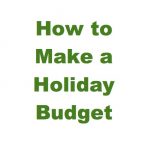
Have you ever wanted to create a budget for yourself, but didn’t know where to start?
Perhaps you’re interested in keeping a closer eye on your finances in general.
In this post I’ll explain how to prepare a simple budget.
It doesn’t matter how much money you have or how much you are looking to save; everyone can benefit from a budget!
While budgeting often gets a bad rap for being boring and restrictive, it really is a lifesaver.
Budgeting not only helps ensure your basic and immediate needs are covered, but it can also help you plan for the future in terms of your savings.
Not a bad deal!
You can create your budget using a computer spreadsheet or plain pen and paper.
Choose your method of note-taking and let’s get started:
Determine your monthly income.
Monthly income can come from your job, a business, or other financial considerations.
If you don’t know how much money you receive per month, week or year, now’s a good time to get on top of it and get the numbers down pat.
Pull out your past pay stubs and other monthly financial documents and add everything up.
How much money do you have at your disposal on average per month? Write this number down.
Figure out basic living expenses.
Basic living expenses include items such as rent or mortgage payments, electric, water, phone and gas bills and other must-have items.
Determine how much your basic living expenses cost by looking at your monthly bills, payments and obligations from the past few months.
Be sure to check bills, invoices, receipts, bank statements and credit card receipts and write down both the budget item and how much each item costs.
If you are in doubt as to how much something costs, for example if you have a cell phone bill that wavers between 82 dollars and 87 dollars a month, round-up the bill to $90.00 per month. It’s easier to deal with money in hand, versus money lost.
Here’s a list of basic living expenses to get you started:
- Mortgage payments
- Rental payments
- Telephone (landline) bill
- Cell phone bill
- Internet bill
- Water bill
- Cable bill
- Electric bill
- Heating (gas/oil) bill
- Car payments
- Car insurance
- Health insurance
- Home insurance
- Life insurance
- Credit card bills
- Loans (student loans, personal loans, etc.)
- Clothing
- Food
- Toiletries
- Medicine
- Retirement accounts (401Ks, IRAs, Roth IRAs, SIMPLE, etc.)
- Daycare or childcare
- etc.
Break out additional budget items.
Now it’s the time to take a deeper dive and look into additional budget items.
Begin by listing out any savings you’d like to start, such as setting aside a little bit of money for an upcoming vacation, wedding, retirement funds, a down payment for a new house, an emergency fund, or just a rainy-day fund for something that catches your eye at the store.
Then, start breaking out non-essential items, such as funds for eating out, entertainment (concerts, movies, short trips), and so on.
Start adding things up.
Take a look at your three budget categories: basic living expenses, savings and non-essential items and see how things are adding up.
Does your monthly income cover all of these items? If not, it’s time to do some reevaluating.
You’ll first want to make sure your basic living expenses and savings are covered. Where can you reduce your spending?
For example, if you spend a lot on non-essential items, you may consider eating out less often, reducing clothing shopping trips, or cutting back or canceling subscriptions, memberships or services you are signed up to but no longer use.
Continue readjusting your numbers as necessary.
Finalize your budget.
You should now have a good idea as to exactly how much money you’ll spend and save each and every month.
Finalize your budget by creating a new document and writing down each budget line item along with the cost of each item. Date and store your budget in a safe place and date it so you can refer to it as needed and make adjustments along the way.
You could also create a spreadsheet for each month of the year to track your budget.
Track your budget regularly.
The only way to stay on top of a budget is to track it! It is absolutely essential to follow and review your budget on a regular basis to make sure things are running smoothly.
You’ll want to carefully watch incoming monthly funds, as well as any changes in bills, and your own spending habits.
How about you? Do you have a budget in place for expenses? Will you set one up now to keep your finances in check? Join in the conversation and leave a comment below!





0 Comments